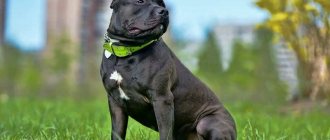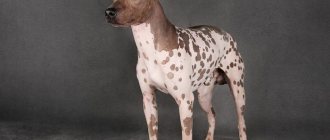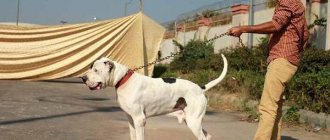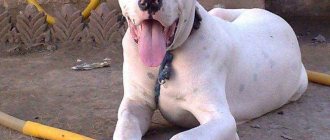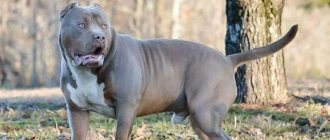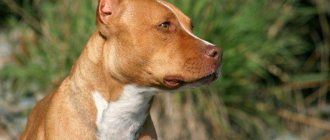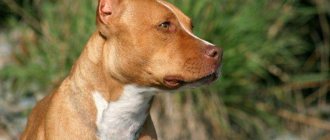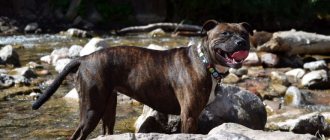The American Bully breed is, first of all, companions that demonstrate confidence and enthusiasm. Despite their powerful appearance, they behave softly and friendly. This breed makes an excellent family companion dog. The ideal American Bully has the athleticism to excel in athletic competition. Aggressive behavior towards people is uncharacteristic of the breed and is extremely undesirable when breeding. Physically, the ideal American Bully is athletic and strong. The American Bully has strong, well-defined muscles that give the impression of great strength as well as athletic ability. Males are usually stockier and larger than females. Their lifespan ranges from 10 to 14 years.
This unique breed is extremely tolerant of children and extremely eager to please its family. Physically, he has a graceful yet imposing, strong, athletic build, muscular and toned, signifying strength and agility.
In addition to being one of the most impressive breeds on the planet, they make excellent family companions, service animals, therapy dogs, and can be incredibly gentle with children.
Buli - pocket, standard, classic and XL
The American Bully " Classic " is a type of American Bully with a lighter body (lighter bone structure) and less overall muscle mass than the standard American Bully, but having approximately the same height.
Description of the American Bully breed
Popularity 11th among 263 dog breeds
Lifespan:
8-12 years
Breed group:
Withdrawn
Height:
40-57 cm
Country of origin:
USA
Average price:
150 thousand rubles
Weight:
30-58 kg
Latest articles Cat health
Rabies vaccination for cats: choice of vaccine, necessity, schedule 01/22/2022 4 0 0
Selection and adaptation
TOP 20 best cat breeds for families with children 01/22/2022 25 0 0
Health
Bully was bred recently, and not all “breed” diseases have been identified. Therefore, it is highly advisable to have a full examination at a veterinary clinic every six months in order to promptly identify possible pathologies.
However, overall this is a healthy, robust breed. Average life expectancy is 8-14 years.
Diseases
American Bullies are genetically prone to:
- hip dysplasia;
- cardiovascular pathologies;
- demodicosis;
- congenital heart failure;
- dislocated kneecaps;
- cataracts;
- cleft lip;
- problems with teeth.
If the American Bull has become weak, has shortness of breath, drowsiness, or moves poorly, it is necessary to urgently show the dog to the veterinarian.
Vaccinations
Vaccination is the only way to protect your pet from deadly infections. Dogs are vaccinated as standard:
- at 8 weeks they give a comprehensive vaccination against canine distemper, hepatitis, enteritis, adenovirus;
- at 12 weeks - second vaccination;
- after 2 weeks or six months - rabies vaccination;
- at 6 – 7 months – revaccination;
- Dogs over 12 months old are vaccinated annually.
Key facts
This is a young breed that has become popular with many dog breeders. Description of the American Bully breed has four officially accepted types: standard, classic, pocket (pocket) and XL.
The threatening appearance of the dog and its aggressive grin should not mislead people. Behind the mountain of muscles hides a very gentle disposition. The characteristics of the American Bully breed indicate the good nature of the strong guy. He is ideal for families with small children or other animals because he is gentle with everyone.
Pets can be good guards, but they practically do not show aggression towards strangers, scaring away well only with their appearance. The breed is not recommended for novice dog breeders, as education and training require experience and the ability to dominate.
The lifespan of an American Bully depends on its size and living conditions and ranges from 8 to 12 years. Other names for the breed are ambully, bullypit, and American bully pit.
Theses
- They love their owner very much and will give their life for him.
- But, at the same time, they are willful and stubborn and are not suitable for inexperienced dog owners, as they can behave badly.
- They do not tolerate other dogs well and are always ready to fight.
- Cats and other small animals are even worse affected.
- They adore children and tolerate their antics.
- These dogs have a very high pain threshold.
History of the origin of the American Bully
The appearance of the breed took place in the 90s of the last century. However, its ancestors have been known for a very long time. These are the famous fighting animals - bull terriers and Staffordshire terriers. The latter in America received a different name - American pit bull terriers.
Fighting representatives were intended to participate in bloody championships and fights in underground betting, so their genetics contained excessive aggression and a ferocious disposition.
Strict prohibitions on cruel entertainment required breeders to breed a companion dog, paradoxically combining an aggressive exterior and an easy-going character.
American breeders began working on creating the breed independently of each other. But they completed their task: a new breed was born, in which there is no total aggression and ferocity.
Despite the youth of the breed, there is no reliable information about who was used for controlled matings. Therefore, the official progenitor individuals are the pit bull terrier, Staffordshire terrier, French and English bulldog.
The Ambully (not to be confused with the Ambuli, that is, the American Bulldog) received official recognition in 2004 in the United States. The breed has not yet been registered in international registries. Despite this, the number of American bullies is actively growing and is spreading far beyond the borders of the United States.
Similar dog breeds
Bull Terrier
American Bulldog
American Pit Bull Terrier
Staffordshire Bull Terrier
American Bully appearance
General impression
In the photo, the American Bully resembles its ancestors - fighting bulldogs. Attention immediately focuses on their stocky and strong physique. The presence of powerful muscles does not interfere, but helps pets to be agile and fast. Ambulli is quite compact and belongs to medium-sized individuals.
Head
The dog's skull is square in shape and of medium length. In proportions it corresponds to the body of the dog. The head is clearly defined and has a pronounced frontal part. The muscles, especially in the cheek area, are well developed.
The muzzle itself is massive and wide, shorter in length than the length of the skull. There may be some slight creases. The transition from the frontal part to the muzzle is quite clear and deep.
The nose is wide and straight, with a large lobe and large nostrils. The lobe can be any color except red.
The dog's ears are set high and tilted forward, as if the ambully is worried about something. At the owner's request, the ears are cropped or left as is. Both options are not considered a violation of the standard.
The animal's eyes are located wide, low and deep in relation to the skull. The eye shape is almond-shaped. The iris can be of any color - the only deviation is blue and blue tint.
The massive jaws have a scissor bite. The lower part of the jaw is larger than the upper. The teeth are strong.
Neck
The cervical region is of medium length and prominent muscles. It narrows from the back of the head to the back. There is a small arc in the nape area.
Some laxity of the skin on the neck is acceptable for representatives of the XL category. Other types of dogs have tight and elastic skin.
Torso
Despite its massive build, the dog looks compact. The case format is square. This means that the distance from the withers to the elbows and from the elbows to the limbs of the ambully is the same. A small discrepancy in values is considered an acceptable but undesirable option.
The chest is powerful, with rounded ribs. The chest appears very wide due to the large distance between the front legs.
The back area is short and strong. Some elevation in relation to the croup is acceptable. The lumbar region is wide. The belly line is selected.
Front and hind limbs
The front legs are powerful, slightly turned towards the forearm. The shoulders are laid back, the elbow bones are pressed tightly to the chest. Sometimes a small gap between the elbows and the chest is acceptable.
The dog's pasterns are massive, but flexible. They are located at a slight angle to the ground. The paws are round in shape and fully proportional to the size of the American Bully.
The hind legs stand straight and parallel to each other. They have strong bones and developed muscle mass. The hock joints are low and well arched. The hind metacarpus are perpendicular to the ground and have rounded paws.
Tail
The tail section is very massive and can have either a hook-shaped or straight shape. The tip is narrowed. The tail is set low and hangs down to the hocks when at rest.
During movement, the tail rises and continues the line of the back. When excited or in a state of alarm, the tail is positioned over the back, but does not curl.
Movement
All movements of the ambully are confident and impressive. He moves warily, but is always ready for sudden jumps or turns.
It is common for dogs of this breed to push strongly with their hind legs. During movement, the spine line is straight, the paws do not cross and do not step out or in. If the ambully runs, then the limbs move slightly closer to the center.
Wool
The entire body of the American Bully is covered with short, moderately coarse hair. The hair fits tightly to the body and shines in any light. The dog has no undercoat. There are no bald areas either.
Color
According to breed standards, different combinations of colors and types of points may be acceptable in the color of an American Bully. Among the representatives of the American Bully, there is only a merle type color - merle.
Dimensions
The size of the American Bully depends entirely on the category to which it belongs. The standard of the breed is the standard type. This is the most numerous category. Males of a standard American Bully range in height from 43 to 51 cm, and females from 40 to 48 cm.
A smaller version of standard individuals is called a classic and is similar in appearance to pit bulls and Staffordshire terriers. The height at the withers is the same as the standard - it is 43-51 cm for males, 40-48 cm for females.
The smallest category is the pocket type. Externally, it corresponds to the standard, but the height of males varies from 36 to 43 cm, the height of females - from 33 to 40 cm.
The giants include representatives of the XL category. Males are 51-57 cm, females are 48-54 cm.
The weight of the American Bully depends on the category and averages 30-58 kg.
Varieties of colors
The standard allows any color, with the exception of merle (marble).
Color Variations
The table shows the colors that are used when entering into the All-Russian Unified Pedigree Book (VERK) of the RKF.
| № | Russian | English |
| 1 | black | black |
| 2 | brown | brown |
| 3 | blue | blue |
| 4 | lilac | lilac |
| 5 | ginger | red |
| 6 | white | white |
| 7 | black and tan | black&tan |
| 8 | brown-fawn | brown&tan |
| 9 | blue and tan | blue&tan |
| 10 | lilac and tan | lilac&tan |
| 11 | black and white | black&white |
| 12 | brown-white | brown&white |
| 13 | blue-white | blue&white |
| 14 | lilac-white | lilac&white |
| 15 | red and white | red&white |
| 16 | black and white with tan | black&white&tan |
| 17 | brown and white with tan | brown&white&tan |
| 18 | blue-white and tan | blue&white&tan |
| 19 | lilac-white with tan | lilac&white&tan |
| 20 | black and brindle | black with brindle tan |
| 21 | brown brindle | brown brindle |
| 22 | blue brindle | blue brindle |
| 23 | lilac brindle | lilac brindle |
| 24 | brindle | brindle |
| 25 | black and white with brindle tan | black&white with brindle tan |
| 26 | brown-white with brindle tan | brown&white with brindle tan |
| 27 | blue-white with brindle and tan | blue&white with brindle tan |
| 28 | lilac-white with brindle tan | lilac&white with brindle tan |
| 29 | brindle white | brindle&white |
| 30 | brown-tiger-white | brown brindle&white&tan |
| 31 | blue-tiger-white | blue brindle&white |
| 32 | lilac-tiger-white | lilac brindle&white |
| 33 | blue-fawn | blue fawn |
| 34 | blue-fawn with tan | blue fawn&tan |
| 35 | blue-fawn-white | blue fawn&white |
| 36 | blue-fawn-white with tan | blue fawn&white&tan |
American Bully character
The efforts of breeders to eradicate total aggression in the genes of dogs of this breed were crowned with success. The character of the American Bully is friendly and cheerful. A stern and even cocky appearance does not prevent them from easily making contact with people. Dogs are very sociable, love affection, and eagerly accept petting.
Unlike their ancestors, bullies get along well in any group. They communicate well with children, allowing themselves to be squeezed and stroked. They do not get tired of active games and jogging, so they will be excellent companions for lovers of an active lifestyle. The American Bully also favors living in the same territory with other pets.
Ambullies easily pick up on the moods of the people around them and are ready to defuse a tense situation with a funny act. Recognizing all family members, they choose only one as the owner. They will obey and please him without question.
The ambully is devotedly and endlessly attached to its owner. The worst punishment for a pet is separation from a loved one.
Dogs tolerate loneliness well, but only for a short time. This is a social animal that becomes strongly attached to people and requires constant attention from them.
The frightening appearance and fairly developed hunter instincts do not make the bully a good watchman. Natural ferocity has been eradicated from him. But he is a wonderful protector: the dog is ready to save a loved one from harm at the cost of his life.
Application
The main purpose of bullies is as a companion. Sometimes it is used as a working dog - to guard property or protect people.
However, the watchman from “American Bruiser” is bad. He lacks aggression and possessiveness. But in terms of security qualities, everything is excellent - as soon as the dog senses a threat to himself or family members, he becomes a fearless defender. He will not be frightened by any threats - the pet will stand to death.
Education and training
All bully owners note his high intelligence and good learning ability. But this does not mean that raising and training an American Bully is without difficulties. It is important to begin early socialization of a growing pet, accustoming it to new sounds, smells, people and animals around it.
The main rule in raising these dogs is a minimum of severity. Under no circumstances should you physically punish a bully. This can embitter him and turn him into an uncontrollable individual.
Before starting basic training, you need to build a trusting relationship with a strong guy and at the same time become a leader for him. If this does not happen, then further communication and education of the dog will be problematic.
Ambullies should not be allowed to take the main position in relations with the owner. For advice on how to conduct training, it would be a good idea to contact an experienced dog handler. He will tell you at what point the dog should be reined in and when to reward it.
Dog training at home can only be carried out if the owner is sufficiently experienced in this matter. A beginner is unlikely to be able to cope with a pet, which will definitely show its obstinacy.
It would be a good idea to enroll your animal in obedience courses: OKD or UGS. They are conducted by trainers who know the character of fighting breeds. Ambullies can be enrolled in both a general and an individual group. Puppies are taken there after 6 months.
Looking for an American Bully? Find your pet from 1 offer Buy
Learning ability
Raising a decent American Bully is not difficult - he is initially focused on contact with the owner and does not strive for dominance. The dog's obedience is sometimes amazing - even in moments of strong excitement, he returns to his place on command, lets go of the prey, or sits down calmly.
A bully puppy must initially be trained to a toilet and a place in the house. Then explain the feeding regime and rules - do not approach the bowl without permission.
It is imperative to socialize the animal in order to form behavioral habits when communicating with other dogs.
Despite the developed intelligence of a dog, when training, commands should be entered consistently. No dog is capable of learning a whole set of exercises in a day. If the task does not work out, you should not swear at the dog - the good-natured bully will be offended and lose trust for a long time. Using physical force as punishment will only make the problem worse.
Praise is enough as encouragement, but occasionally you can reinforce the word with a treat. The main thing is not to overdo it, so that the dog does not get used to working only for food.
American Bully Health and Diseases
Possible diseases
Representatives of the American Bully breed have excellent genetics, so they are considered dogs with good immunity and enviable health. But there are times when they become vulnerable.
For example, ambullies do not tolerate heat well. This forces them to seek shade or sit in cool rooms during sunny days. The owner must take into account this feature of his four-legged friend and prevent him from overheating and thirst.
Other diseases of ambullies inherited from their parents:
- Cataract
, optic nerve atrophy. The disease develops with age and is transmitted genetically.
- Joint dysplasia
. The problem can be noticeable from an early age. If promptly contacted by a veterinarian, it can be successfully treated.
- Dental diseases
. The anatomy of the oral cavity contributes to the formation of plaque and tartar. If you do not monitor the condition of the oral cavity, the development of caries, periodontal disease and other ailments is inevitable.
- Demodicosis
. A skin pathology caused by an almost invisible worm-shaped mite. In its advanced form, the disease affects not only the skin, but also the internal organs. Without treatment, the dog may die.
A fairly small list of ambully diseases does not mean that the owner of a robust dog can ignore preventive visits to the veterinarian or annual vaccinations. Only a set of measures to maintain strong immunity will help minimize the possibility of dangerous pathologies. We must not forget about regular treatment for intestinal and skin parasites.
Reproductive health
Puberty in females occurs by 1 year. From this age, your pet can be sterilized, but she is not ready to reproduce healthy offspring.
Mating is carried out during the third estrus, which occurs at 20 months of the female’s life. Mating is carried out on the territory of the dog.
Mating
Since bullies “mature” for a long time, the first mating is carried out no earlier than 1.5 years. It is advisable to breed a female dog after her 3rd heat.
Before knitting you must:
- treat the dog for parasites;
- get all vaccinations;
- get tested for possible infections.
Important! Only completely healthy animals are bred.
For successful fertilization, 2 matings are required with a break of a day. Mating is best done in the male dog's territory. For the next few days, the bitch is not allowed off the leash - the heat is still ongoing, and she may rush off to look for another father for the puppies.
Features of feeding and diet
The anatomical features of the breed require a carefully thought-out diet. A deficiency in certain substances can cause irreparable harm not only to the appearance, but also to the internal state of the animal.
Both industrial food and natural diet are suitable for feeding the American Bully. This is entirely the owner's choice. The undeniable advantages of the first type of food are considered to be complete balance. Indeed, the formulation of purchased food contains all the nutrients, microelements and vitamins necessary for the development of a pet.
By using high-quality industrial feed such as super-premium and holistic, the owner will not have to additionally introduce vitamin and mineral supplements into the diet. This applies to dry food and canned food.
Supporters of a natural diet use lean meat and offal to feed ambulli. The best cereals are rice and buckwheat, as well as millet. They can be used separately or combined.
Twice a week it is beneficial for your pet to eat low-fat fermented milk products. It is good to add vegetable oil to cooked food. A dog should consume no more than one tablespoon of oil per day.
To enrich the diet and increase the amount of fiber, boiled or raw vegetables and fruits are added to food. Dogs are strictly prohibited:
- sweets;
- River fish;
- full fat milk;
- citrus fruits and berries;
- onion and garlic;
- bakery;
- spicy and smoked products.
Ambulli puppies begin to be fed from one month old, using low-fat cottage cheese, eggs, and viscous porridge. Babies are fed 5 times a day, adolescents and adults no more than 2 times - in the morning and in the evening. You can’t feed the ambully with food from the owner’s table to avoid obesity or allergic reactions to food.
What to feed boules?
The owner decides what the bully will eat. Today there are two directions of feeding:
- natural food;
- industrial feed.
It is important that your dog gets enough protein
There are many arguments for each direction. Whatever you choose, remember that at least 70% of the animal’s daily diet should be protein. It turns out this:
- you can buy a holistic food with a high protein content and give your dog its daily portion twice a day;
- ensure the supply of protein to the animal by feeding mainly meat, fish, and offal.
It is very important that the dog does not suffer from vitamin deficiency. Holistic food is initially saturated with vitamins, so there is no need to purchase additional ones, but adherents of natural nutrition will have to consult a veterinarian and buy suitable ones.
High-quality industrial feed should be premium or holistic class
Care and maintenance
American Bullies feel good both in a country cottage and in an apartment. The main condition for their maintenance is regular walking, which should occur at least twice a day. Walks should be combined with elements of play and active jogging.
In general, keeping and caring for an American Bully is not labor-intensive and mainly consists of hygiene procedures necessary for short-haired individuals. There is no need to brush your dogs daily. For their coat type, a weekly brushing with a rough brush is sufficient. During seasonal shedding, brushing can be done twice a week.
In order not to reduce the natural layer of fat on the dog's surface, it is not necessary to bathe it more than twice a month. Too frequent water procedures lead to disruption of the functioning of the sebaceous glands and the appearance of a specific odor from the surface of the skin. In case of frequent contamination, it is enough to wipe the dog’s body with a damp towel or use dry shampoo.
Your pet's eyes and ears need to be examined weekly and wiped with a damp cotton pad to remove debris. Due to the structure of the jaw, bully teeth are susceptible to plaque formation. To keep them clean, use a special brush and paste. Special treats in the form of bones made from compressed veins or toys made of silicone will also help in cleaning your teeth.
The owner’s task is to monitor the condition of the four-legged friend’s claws. If they are not ground down to the desired level, then they are trimmed. It is important to pay attention to your pet's paw pads. They must be without damage, and in winter it is necessary to prevent the ingress of reagents that cause burns.
Pros and cons of the breed
The American Bully is not suitable for elderly people or children as a pet. The owner of such a dog must have a strong and calm character, be strong-willed and fair.
The main advantages and disadvantages of the American Bully breed are outlined below.
Pros:
1. Devotion. 2. Friendly nature. 3. Easy care. 4. Suitable for apartment maintenance.
Tips for choosing a puppy
In Russia there are no more than ten nurseries that breed American Bully puppies. They are located in large cities (Moscow, St. Petersburg) and have an impeccable reputation.
There is no point in purchasing a baby anywhere else. Most likely, pit bull and amstaff puppies are passed off as purebred bullies. The babies are very similar, so only a specialist can notice the substitution.
The tasks of the future owner when choosing a purebred friend are as follows:
- find a specialized nursery;
- decide on the Ambulli category: standard, classic, pocket or XL;
- find out breed standards.
Having looked at the puppy you like, you need to ask the breeder about his parents, look at their veterinary passports and pedigrees. It wouldn't hurt to watch your baby for a while. By the time of sale, he should be confident on his feet, active and curious.
By the age of 1.5-2 months, the puppy feeds on its own, so you need to find out the type of its diet. When purchasing, the breeder must provide the dog's pedigree and veterinary passport.
How to choose a puppy
Buying a kitten is a responsible undertaking. Even more trouble is added if you take such a young and popular breed as the American Bully.
The American Bully and Pitbull are somewhat similar, especially during puppyhood. Therefore, baby Pit dogs are often sold to inexperienced owners under the guise of a new breed.
It is better to take puppies from large nurseries. The ideal option is to buy in the USA, but Americans are not willing to give breeding and show animals to foreigners. Therefore, it is worth taking a closer look at clubs in Russia.
It is desirable that both parents are from America. Before you buy a puppy, you need to get to know the parents - the kids will inherit their physique and disposition.
The ideal Bully puppy should:
- have a good appetite;
- easy to make contact;
- be playful, not aggressive;
- have no external defects - excessive fatness, thinness, nitrous eyes, dirty ears indicate health problems.
It is imperative to check the pedigrees of the parents, passports of the mother, father and puppies. Babies must be vaccinated.
Don't be afraid to ask breeders questions. Adequate owners love them - this shows the interest and responsibility of the future owner. Unscrupulous “divorcees” avoid questions.
